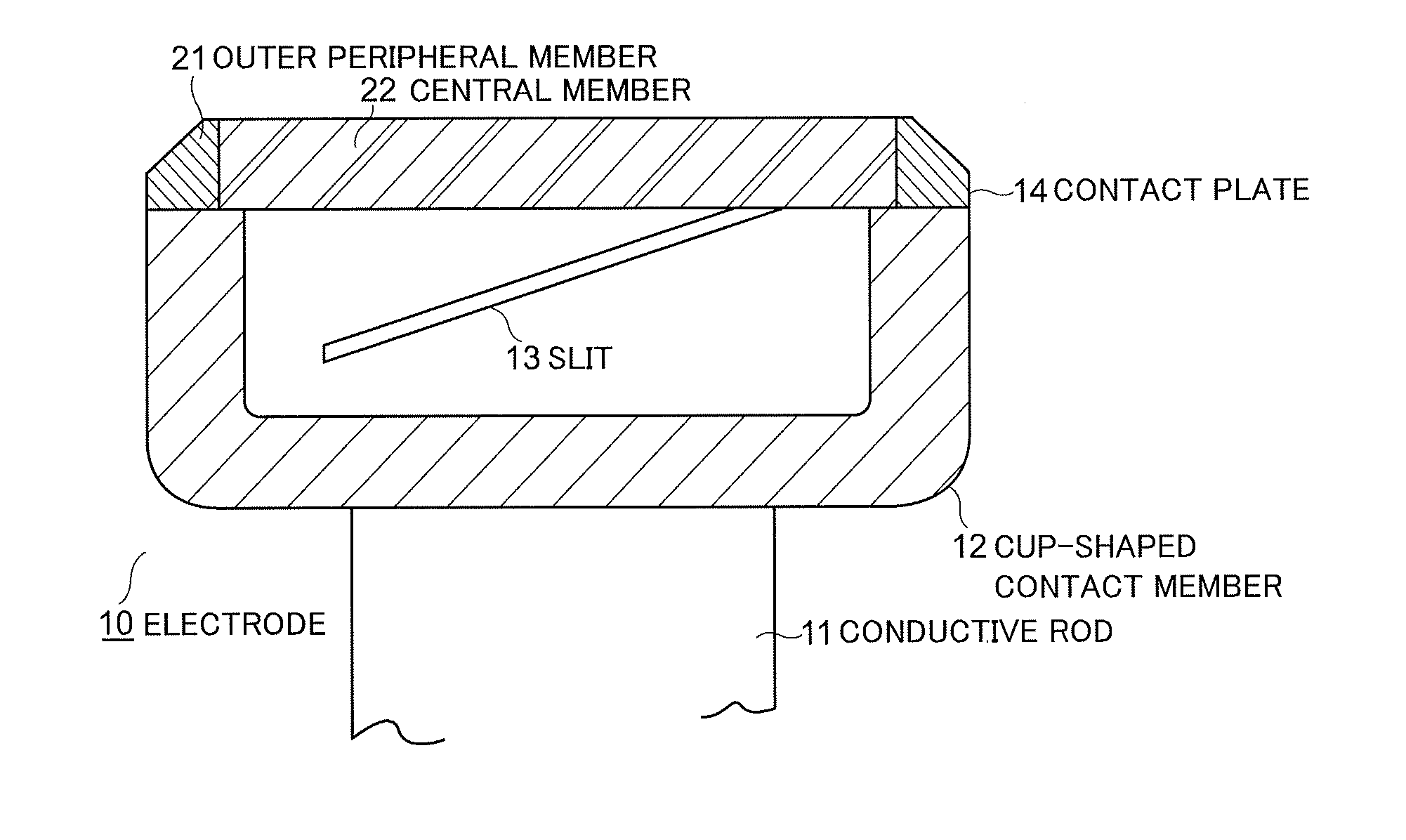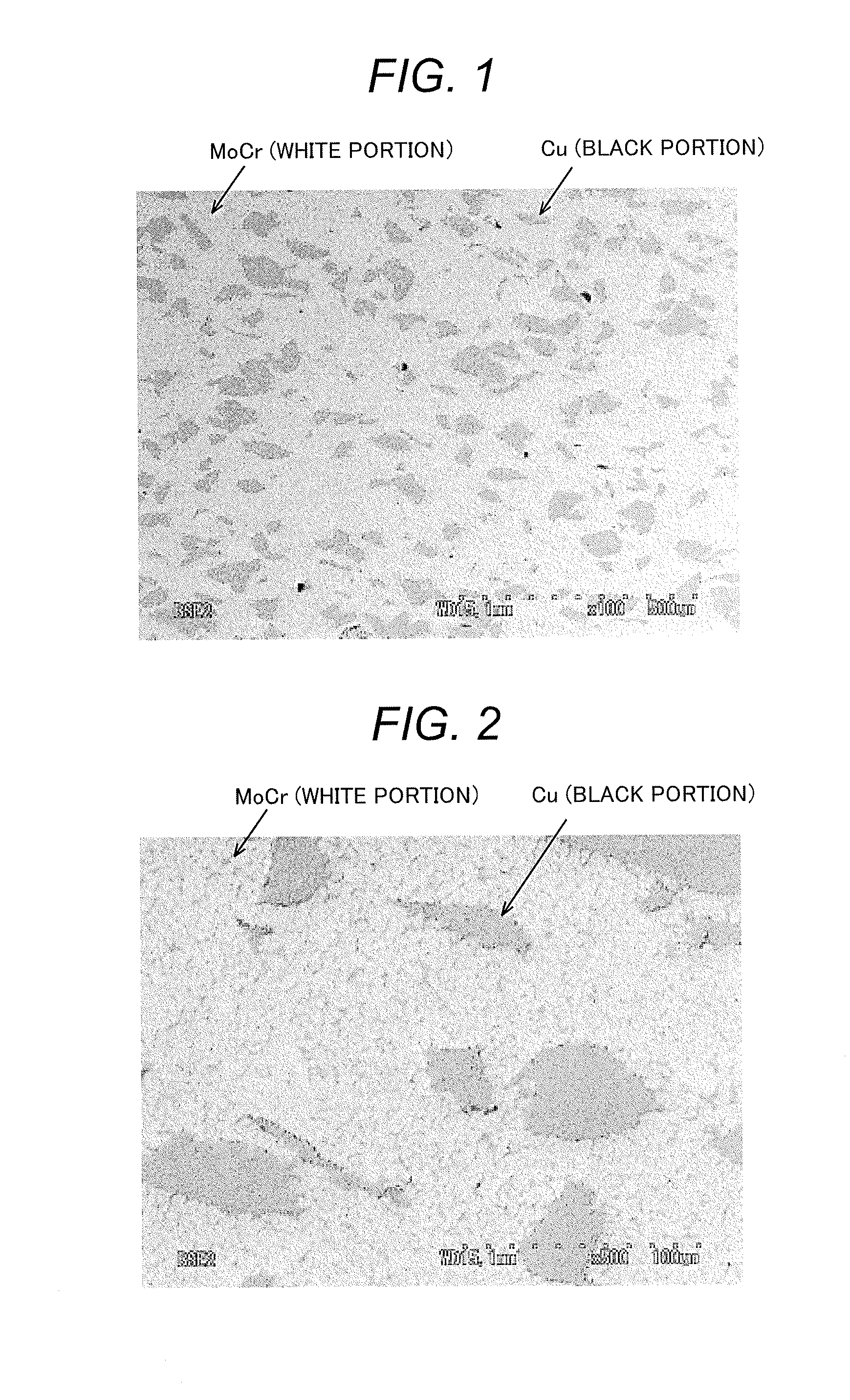Method for Producing Electrode Material for Vacuum Circuit Breaker, Electrode Material for Vacuum Circuit Breaker and Electrode for Vacuum Circuit Breaker
a technology of vacuum circuit breakers and electrodes, which is applied in the direction of contacts, metal/alloy conductors, and conductors, etc., can solve the problems of reducing the conductivity of the material, increasing the contact resistance, and lowering the performance of high current interruption, so as to improve the arc resistance, the effect of easy production of electrode materials and improved arc resistan
- Summary
- Abstract
- Description
- Claims
- Application Information
AI Technical Summary
Benefits of technology
Problems solved by technology
Method used
Image
Examples
embodiment 1
[0030]The following explains the method for producing electrode material for vacuum circuit breaker and then the electrode material for vacuum circuit breaker. The producing of the electrode material for vacuum circuit breaker uses Mo powder and Cr powder as the chief material. Mo powder used is a commercially available Mo powder having a particle diameter of 0.8 to 6 μm. Cr powder used is a thermite Cr (a metal Cr powder formed by thermite reduction) powder because an ordinary fine powder of Cr is not usable as it is easily-oxidizable. Thermite Cr powder should preferably have a particle diameter of about 40 to 80 μm; however, a commercially available powder having a particle diameter of 40 to 300 μm may be used. A commercially available thermite Cr powder is usable because the oxygen content of such thermite Cr powder is 500 to 1200 ppm, not over 1200 ppm.
[0031]Mo powder and a thermite Cr powder are, as is detailed later, mixed together homogeneously at a mixing ratio of 1:1 or ov...
embodiment example
of Electrode Material for Vacuum Circuit Breaker and Comparison Example
[0036]Table 1 lists embodiment examples and a comparison example. The embodiment examples are electrode materials, which are listed as Samples No. 1 to No. 12, produced by the method that the present invention defines, which method is comprised of the mixing step, the press-sintering step, and the Cu infiltration step. The comparison example, which is listed as Sample No. 13, is an electrode material for vacuum circuit breaker manufactured by a conventional method using Cu—Cr as the main constituent.
TABLE 1CompactionContentMo:Crpressure onContactBrinellSample(wt %)MixingMoCrresistancehardnessEvaluationNo.CuMoCrratio(t / cm2)(μΩ)(HB)resultNo. 14045153:144.5260⊚No. 2306379:147.2197⊚No. 3375013About48.4229⊚4:1No. 4414514About32.6182⊚3:1No. 5513811About13.699⊚3:1No. 63433331:145.2179ΔNo. 7413029About33.4205Δ1:1No. 8552322About13.8158Δ1:1No. 92818541:348.0154XNo. 103616481:336.0191XNo. 115212361:314.3148XNo. 12593110Abo...
embodiment 2
[0046]Next, an electrode for vacuum circuit breaker by the present invention illustrated in FIG. 4 that uses the above-stated electrode material is explained hereunder. An electrode 10 of axial magnetic field type on the fixed side or moving side has a cup-shaped contact member 12 fixed on the end of a conductive rod 11. A part of the outer periphery of the cup-shaped contact member 12, which part is on the opposite side of the conductive rod 11, has a plurality of slits 13 that are slant with respect to the axis, which form current paths as a coil portion similarly to the conventional art. On the end face of the cup-shaped contact member 12 where the slits 13 are formed, a contact plate 14 is firmly fixed. The face of the contact plate 14 contacts with another contact plate on the other electrode to flow current; on the other hand, arcing on the face of the contact plate 14 on current interruption when electrodes open the circuit.
[0047]By the present invention, the contact plate 14...
PUM
| Property | Measurement | Unit |
|---|---|---|
| particle diameter | aaaaa | aaaaa |
| particle diameter | aaaaa | aaaaa |
| temperature | aaaaa | aaaaa |
Abstract
Description
Claims
Application Information
 Login to View More
Login to View More - R&D
- Intellectual Property
- Life Sciences
- Materials
- Tech Scout
- Unparalleled Data Quality
- Higher Quality Content
- 60% Fewer Hallucinations
Browse by: Latest US Patents, China's latest patents, Technical Efficacy Thesaurus, Application Domain, Technology Topic, Popular Technical Reports.
© 2025 PatSnap. All rights reserved.Legal|Privacy policy|Modern Slavery Act Transparency Statement|Sitemap|About US| Contact US: help@patsnap.com



